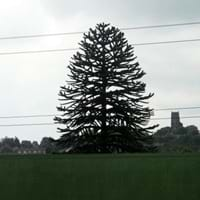Life Span
Perennial
Perennial
Type
Perennial
Needled or Scaled Evergreen
Origin
Southeastern United States, North-Central United States, Central United States, South-Central United States, Southwestern United States, Texas, Canada, Mexico
Argentina, Chile
Types
Not Available
not available
Habitat
Dry areas, Prairies, Rocky areas, rocky outcrops
Subtropical forests
USDA Hardiness Zone
3-10
7-11
Sunset Zone
A1, A2, A3, H1, H2, 1a, 1b, 2a, 2b, 3a, 3b, 4, 5, 6, 7, 8, 9, 10, 11, 12, 13, 14, 15, 16, 17, 18, 19, 20, 21, 22, 23, 24
H1, H2, 4, 5, 6, 7, 8, 9, 14, 15, 16, 17, 18, 19, 20, 21, 22, 23, 24
Habit
Upright/Erect
Oval or Rounded
Minimum Width
Not Available
Flower Color
Yellow, Purple, Burgundy, Light Green, Brown
Green
Flower Color Modifier
Bicolor
Bicolor
Leaf Color in Spring
Light Green, Gray Green
Green, Dark Green
Leaf Color in Summer
Light Green, Gray Green
Dark Green
Leaf Color in Fall
Light Green, Gray Green
Dark Green
Leaf Color in Winter
Light Green
Dark Green
Leaf Shape
Subulate
Needle like
Plant Season
Summer
Spring, Summer, Fall, Winter
Sunlight
Full Sun
Full Sun, Partial Sun
Type of Soil
Loam, Sand
Clay, Loam, Sand
The pH of Soil
Neutral
Acidic, Neutral, Alkaline
Soil Drainage
Well drained
Well drained
Bloom Time
Late Spring, Early Summer, Summer, Late Summer
Not Available
Tolerances
Drought
Drought
Where to Plant?
Ground
Ground, Pot
How to Plant?
Seedlings
Tip cutting
Plant Maintenance
Medium
Medium
Watering Requirements
Average Water Needs, Water in morning to avoid prompting diseases
Allow to dry out slightly between watering
In Summer
Lots of watering
Lots of watering
In Spring
Moderate
Moderate
In Winter
Average Water
Average Water
Soil pH
Neutral
Acidic, Neutral, Alkaline
Soil Type
Loam, Sand
Clay, Loam, Sand
Soil Drainage Capacity
Well drained
Well drained
Sun Exposure
Full Sun
Full Sun, Partial Sun
Pruning
Cut or pinch the stems, Pinch Tips, Remove damaged leaves, Remove dead branches, Remove dead flowers, Remove dead leaves, Remove dead or diseased plant parts, Remove deadheads
Remove damaged leaves, Remove dead branches, Remove dead leaves
Fertilizers
All-Purpose Liquid Fertilizer, Apply N-P-K
All-Purpose Liquid Fertilizer
Pests and Diseases
Pests and diseases free, Red blotch
Anthracnose, Branch Droop, Root rot, Yellow Leaves
Plant Tolerance
Drought, Dry Conditions, Dry soil, Full Sun
Drought
Flowers
Showy
Insignificant
Flower Petal Number
Single
Single
Fragrant Bark/Stem
No
Yes
Foliage Texture
Fine
Fine
Foliage Sheen
Matte
Glossy
Attracts
Birds, Butterflies
Not Available
Allergy
Rhinitis
Not Available
Aesthetic Uses
Borders
Showy Purposes, Used as Christmas tree
Beauty Benefits
Not Available
Not Available
Environmental Uses
Air purification
Air purification
Medicinal Uses
Analgesic
Not Available
Part of Plant Used
Flowers
Whole plant
Other Uses
Can be made into a herbal tea, Used in making tea
Used in Furniture, Useful for shade
Used As Indoor Plant
No
Yes
Used As Outdoor Plant
Yes
Yes
Garden Design
Container, Cutflower, Mixed Border, Wildflower
Container, Feature Plant
Botanical Name
RATIBIDA columnifera
ARAUCARIA araucana
Common Name
Mexican Hat
Monkey Tail Tree, Chilean Pine, Pehuén
In Hindi
Mexican Hat
Monkey Puzzle Tree
In German
Mexican Hat
Chilenische Araukarie
In French
Mexican Hat
Araucaria du Chili
In Spanish
mexican Hat
araucaria o pehuén
In Greek
Mexican Hat
Monkey Puzzle Tree
In Portuguese
Mexican Hat
Monkey Puzzle Tree
In Polish
Mexican Hat
Araukaria chilijska
In Latin
Mexicanus Hat
Monkey Puzzle Tree
Phylum
Tracheophyta
Pinophyta
Class
Magnoliopsida
Pinopsida
Family
Asteraceae
Araucariaceae
Clade
Angiosperms, Asterids, Eudicots
Not Available
Tribe
Not Available
Not Available
Subfamily
Not Available
Not Available
Number of Species
Not Available
Not Available
Importance of Mexican Hat and Monkey Puzzle Tree
Want to have the most appropriate plant for your garden? You might want to know the importance of Mexican Hat and Monkey Puzzle Tree. Basically, these two plants vary in many aspects. Compare Mexican Hat and Monkey Puzzle Tree as they differ in many characteristics such as their life, care, benefits, facts, etc. Every gardener must at least have the slightest clue about the plants he wants to plant in his garden. Compare their benefits, which differ in many ways like facts and uses. The medicinal use of Mexican Hat is Analgesic whereas of Monkey Puzzle Tree is Not Available. Mexican Hat has beauty benefits as follows: Not Available while Monkey Puzzle Tree has beauty benefits as follows: Not Available.
Compare Facts of Mexican Hat vs Monkey Puzzle Tree
How to choose the best garden plant for your garden depending upon its facts? Here garden plant comparison will help you to solve this query. Compare the facts of Mexican Hat vs Monkey Puzzle Tree and know which one to choose. As garden plants have benefits and other uses, allergy is also a major drawback of plants for some people. Allergic reactions of Mexican Hat are Rhinitis whereas of Monkey Puzzle Tree have Not Available respectively. Having a fruit bearing plant in your garden can be a plus point of your garden. Mexican Hat has no showy fruits and Monkey Puzzle Tree has showy fruits. Also Mexican Hat is not flowering and Monkey Puzzle Tree is not flowering . You can compare Mexican Hat and Monkey Puzzle Tree facts and facts of other plants too.





